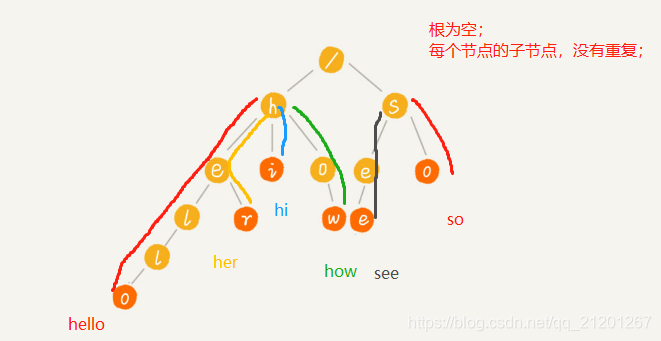文章目录
- 1. Trie树概念
- 2. Trie树操作
- 2.1 存储
- 2.2 查找
- 2.3 插入
- 2.4 删除
- 2.5 打印
- 3. 完整代码
- 4. Trie树与散列表、红黑树的比较
- 4.1 思考题
- 参考文章
- 5. 练习题
1. Trie树概念
- Trie树,也叫字典树,它是一个树形结构。是一种专门处理字符串匹配的数据结构,用来解决在一组字符串集合中快速查找某个字符串。
- Trie树本质,利用字符串之间的公共前缀,将重复的前缀合并在一起。

2. Trie树操作
2.1 存储
Trie树是一个多叉树;二叉树的数据结构里存放着左右子节点的指针;
Trie树采用的一种经典的存储方式是散列表。

class TrieNode//Trie树节点类,假设只有26个字母的数据集
{
public:char data;TrieNode *children[charNum];size_t count;//记录这个节点被多少个单词占用bool isEndOfWord;//是否是一个单词的结束字符size_t freq; //单词插入的频次TrieNode(char ch = '/'):data(ch), isEndOfWord(false), count(0), freq(0){memset(children,0,sizeof(TrieNode*) * charNum);}~TrieNode(){}
};
Trie树比较浪费内存,children数组存放指针;
牺牲点效率的话,可以将数组改成,有序数组,跳表,散列表,红黑树等
2.2 查找
TrieNode* find_private(const string &text) const//查找某个字符串,返回最后一个字符节点的指针
{TrieNode *p = root;int index;for(int i = 0; i < text.size(); ++i){index = text[i] - 'a';if(p->children[index] == NULL)return NULL;//还没匹配完p = p->children[index];}if(p->isEndOfWord == false)//匹配完,但是只是前缀return NULL;else{return p;//私有find无输出信息}
}
时间复杂度O(k),k为要查找的字符串长度
2.3 插入
void insert(const string &text)//插入一个字符串
{TrieNode *p = find_private(text);if(p)//找到了字符串,不用插入,频次加1{p->freq++;return;}p = root;int index;for(int i = 0; i < text.size(); ++i){index = text[i] - 'a';if(p->children[index] == NULL){TrieNode *newNode = new TrieNode(text[i]);p->children[index] = newNode;}p->count++;p = p->children[index];}p->count++;p->freq++;p->isEndOfWord = true;
}
时间复杂度O(n),n为所有字符串长度和
2.4 删除
bool delString(const string &text)
{TrieNode *p = root;stack<TrieNode*> nodeStack;nodeStack.push(root);int index;for(int i = 0; i < text.size(); ++i){index = text[i] - 'a';if(p->children[index] == NULL)return false;//还没匹配完p = p->children[index];nodeStack.push(p);}if(p->isEndOfWord == false)//匹配完,但是只是前缀return false;else{while(nodeStack.top()->count == 1)//删除单词只要自己包含的部分{index = nodeStack.top()->data - 'a';
// cout << "del char: " << nodeStack.top()->data << endl;//(调试代码)delete nodeStack.top();nodeStack.pop();}nodeStack.top()->children[index] = NULL;//断开已删除的部分while(!nodeStack.empty()){nodeStack.top()->count--;//单词占用记录减1nodeStack.pop();}return true;}
}
析构函数
void destory(TrieNode* proot)//树不再使用,结束前,释放资源
{if(proot == NULL){return;}for(int i = 0; i < charNum; ++i){destory(proot->children[i]);}delete proot;proot = NULL;
}
2.5 打印
void printStrWithPre(const string prefix) const//打印有指定前缀的单词{if(prefix.size() == 0)return;TrieNode *p = root;int index,printID = 0;for(int i = 0; i < prefix.size(); ++i){index = prefix[i] - 'a';if(p->children[index] == NULL)//前缀还没匹配成功{cout << "-------------------------" << endl;cout << "no string with prefix: " << prefix << " can be found!" << endl;return;}elsep = p->children[index];}//匹配完了,p指向前缀最后一个字符节点cout << "-------------------------" << endl;cout << p->count << " string(s) with prefix: " << prefix << " , as following:" << endl;printWordsOfNode(p,prefix,printID);cout << "-----------end-----------" << endl;}void printDict() const//字典序输出全部单词{string word("");int printID = 0;cout << "-------------------------" << endl;cout << "all " << itemCount() << " words as following:" << endl;printWordsOfNode(root,word,printID);cout << "-----------end-----------" << endl;}
private:void printWordsOfNode(TrieNode* p, string prefix, int &order) const{//递归打印前缀最后一个字符对应节点下面所有的字符if(p != NULL){if(p->isEndOfWord)//是终止字符,prefix是不断+出来的,是整个字符串cout << ++order << " " << prefix << ", frequency: " << p->freq << endl;for(int i = 0; i < charNum; ++i){if(p->children[i] != NULL)printWordsOfNode(p->children[i],prefix+(p->children[i]->data),order);}}}
3. 完整代码
https://github.com/hitskyer/course/blob/master/dataAlgorithm/chenmingming/string_matching/trie.cpp
/*** @description: trie树,字典树* @author: michael ming* @date: 2019/6/24 19:00* @modified by: */
#include <iostream>
#include <cstring>
#include <stack>
#define charNum 26
using namespace std;
class TrieNode//Trie树节点类,假设只有26个字母的数据集
{
public:char data;TrieNode *children[charNum];size_t count;//记录这个节点被多少个单词占用bool isEndOfWord;//是否是一个单词的结束字符size_t freq; //单词插入的频次TrieNode(char ch = '/'):data(ch), isEndOfWord(false), count(0), freq(0){memset(children,0,sizeof(TrieNode*) * charNum);}~TrieNode(){}
};
class Trie
{
public:TrieNode* root;Trie(){root = new TrieNode;}~Trie(){destory(root);}void insert(const string &text)//插入一个字符串{TrieNode *p = find_private(text);if(p)//找到了字符串,不用插入,频次加1{p->freq++;return;}p = root;int index;for(int i = 0; i < text.size(); ++i){index = text[i] - 'a';if(p->children[index] == NULL){TrieNode *newNode = new TrieNode(text[i]);p->children[index] = newNode;}p->count++;p = p->children[index];}p->count++;p->freq++;p->isEndOfWord = true;}void find(const string &text) const//查找某个字符串{TrieNode *p = root;int index;for(int i = 0; i < text.size(); ++i){index = text[i] - 'a';if(p->children[index] == NULL)//还没匹配完{cout << "can not find string: " << text << endl;return;}p = p->children[index];}if(p->isEndOfWord == false)//匹配完,但是只是前缀{cout << "can not find string: " << text << endl;return;}else{cout << text << " occurs " << p->freq << " time(s)." << endl;return;}}private:TrieNode* find_private(const string &text) const//查找某个字符串,返回最后一个字符节点的指针{TrieNode *p = root;int index;for(int i = 0; i < text.size(); ++i){index = text[i] - 'a';if(p->children[index] == NULL)return NULL;//还没匹配完p = p->children[index];}if(p->isEndOfWord == false)//匹配完,但是只是前缀return NULL;else{return p;//私有find无输出信息}}public:void destory(TrieNode* proot)//树不再使用,结束前,释放资源{if(proot == NULL){return;}for(int i = 0; i < charNum; ++i){destory(proot->children[i]);}delete proot;proot = NULL;}bool delString(const string &text){TrieNode *p = root;stack<TrieNode*> nodeStack;nodeStack.push(root);int index;for(int i = 0; i < text.size(); ++i){index = text[i] - 'a';if(p->children[index] == NULL)return false;//还没匹配完p = p->children[index];nodeStack.push(p);}if(p->isEndOfWord == false)//匹配完,但是只是前缀return false;else{while(nodeStack.top()->count == 1)//删除单词只要自己包含的部分{index = nodeStack.top()->data - 'a';
// cout << "del char: " << nodeStack.top()->data << endl;//(调试代码)delete nodeStack.top();nodeStack.pop();}nodeStack.top()->children[index] = NULL;//断开已删除的部分while(!nodeStack.empty()){nodeStack.top()->count--;//单词占用记录减1nodeStack.pop();}return true;}}size_t itemCount() const//字典中单词种数{return root->count;}void printStrWithPre(const string prefix) const//打印有指定前缀的单词{if(prefix.size() == 0)return;TrieNode *p = root;int index,printID = 0;for(int i = 0; i < prefix.size(); ++i){index = prefix[i] - 'a';if(p->children[index] == NULL)//前缀还没匹配成功{cout << "-------------------------" << endl;cout << "no string with prefix: " << prefix << " can be found!" << endl;return;}elsep = p->children[index];}//匹配完了,p指向前缀最后一个字符节点cout << "-------------------------" << endl;cout << p->count << " string(s) with prefix: " << prefix << " , as following:" << endl;printWordsOfNode(p,prefix,printID);cout << "-----------end-----------" << endl;}void printDict() const//字典序输出全部单词{string word("");int printID = 0;cout << "-------------------------" << endl;cout << "all " << itemCount() << " words as following:" << endl;printWordsOfNode(root,word,printID);cout << "-----------end-----------" << endl;}
private:void printWordsOfNode(TrieNode* p, string prefix, int &order) const{//递归打印前缀最后一个字符对应节点下面所有的字符if(p != NULL){if(p->isEndOfWord)//是终止字符,prefix是不断+出来的,是整个字符串cout << ++order << " " << prefix << ", frequency: " << p->freq << endl;for(int i = 0; i < charNum; ++i){if(p->children[i] != NULL)printWordsOfNode(p->children[i],prefix+(p->children[i]->data),order);}}}
};
int main()
{Trie textlib;string a("hello"), b("her"), c("so"), d("hi"), e("how"), f("see");textlib.insert(a);textlib.insert(a);textlib.insert(b);textlib.insert(c);textlib.insert(d);textlib.insert(e);textlib.insert(f);textlib.find(a);textlib.find(b);textlib.find(d);textlib.printStrWithPre("h");textlib.printDict();textlib.delString("hello");textlib.find(a);textlib.printStrWithPre("h");textlib.printDict();cout << "total kind(s) of word: " << textlib.itemCount() << endl;return 0;
}

4. Trie树与散列表、红黑树的比较
Trie树对要处理的字符串有及其严苛的要求。
- 第一,字符串中包含的字符集不能太大。如果字符集太大,那存储空间可能就会浪费很多。即便可以优化,也要付出牺牲查询、插入效率的代价。
- 第二,要求字符串的前缀重合比较多,不然空间消耗会变大很多。
- 第三,如果要用Trie树解决问题,那我们就要自己从零开始实现一个Trie树,还要保证没有bug,这个在工程上是将简单问题复杂化,除非必须,一般不建议这样做。
- 第四,通过指针串起来的数据块是不连续的,而Trie树中用到了指针,所以,对缓存并不友好,性能上会打个折扣。
- 综合这几点,针对在一组字符串中查找字符串的问题,工程中,更倾向于用散列表或者红黑树。因为这两种数据结构,我们都不需要自己去实现,直接利用编程语言中提供的现成类库就行了。
- Trie 树只是不适合精确匹配查找,这种问题更适合用散列表或者红黑树来解决。
- Trie树比较适合的是查找前缀匹配的字符串,例如搜索引擎智能匹配输入,给出候选提示(如果有多个候选,可以按搜索热度排序,上面代码里面的 frequency)。

- Trie树还可以应用于自动输入补全(输入法,代码编辑器,浏览器网址输入)
4.1 思考题
- 上面针对英文的搜索关键词,对于更加复杂的中文来说,词库中的数据又该如何构建成Trie 树呢?
- 如果词库中有很多关键词,在搜索提示的时候,用户输入关键词,作为前缀在Trie 树中可以匹配的关键词也有很多,如何选择展示哪些内容呢?(按搜索热度或者概率)
- 像Google 这样的搜索引擎,用户单词拼写错误的情况下,Google还是可以使用正确的拼写来做关键词提示,这个又是怎么做到的呢?
参考文章
https://www.cnblogs.com/xujian2014/p/5614724.html
5. 练习题
LeetCode 1707. 与数组中元素的最大异或值(Trie树)
)



)
)



:详解Redis的存储类型、集群架构、以及应用场景)

)
(未解答))
)

:哨兵+复制+事务+集群+持久化等)


))
